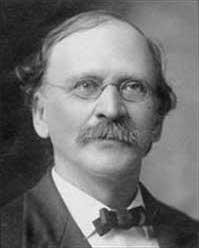Edward Morley facts for kids
Edward Williams Morley (born January 29, 1838 – died February 24, 1923) was an important American scientist. He was a physicist and chemist known for his careful experiments. Morley helped us understand more about light and the tiny parts that make up everything around us. One of his most famous works was the Michelson–Morley experiment, which changed how scientists thought about the universe.
Contents
Who Was Edward Morley?
Edward Morley was born in Newark, New Jersey, and grew up in West Hartford, Connecticut. He was a very bright student from a young age. He went to Williams College, where he studied science and graduated in 1860. Later, he taught at Western Reserve College (now part of Case Western Reserve University) in Ohio. He spent most of his career there, teaching chemistry and doing amazing experiments.
A Pioneer in Precision
Morley was known for being incredibly precise in his measurements. This meant he was very careful to get exact numbers in his experiments. This skill was super important for his work, especially when dealing with things like the speed of light or the weights of atoms. His dedication to accuracy helped science move forward.
The Michelson–Morley Experiment
One of Morley's most famous achievements was working with Albert Michelson on an experiment in 1887. This experiment is now called the Michelson–Morley experiment.
What Was the Experiment About?
At the time, many scientists believed that light needed a special invisible substance to travel through. They called this substance "luminiferous aether" (pronounced EE-ther). They thought the Earth moved through this aether, like a boat moving through water. The Michelson–Morley experiment was designed to find this aether.
How Did They Do It?
Morley and Michelson built a very clever device called an interferometer. This machine could split a beam of light into two paths and then bring them back together. If the Earth was moving through the aether, they expected the two light beams to travel at slightly different speeds. This difference would create a pattern of light and dark fringes, like ripples in water.
The Surprising Result
However, no matter how they set up their experiment, they found no difference in the speed of the light beams. The result was a big surprise! It showed that the "aether" probably didn't exist. This was a huge discovery because it meant that light didn't need a special medium to travel.
Impact on Science
The Michelson–Morley experiment was a key step that led to Albert Einstein's theory of special relativity. Einstein's theory, developed years later, explained that the speed of light is always the same for everyone, no matter how they are moving. This idea completely changed how scientists understood space and time.
Other Important Work
Besides the Michelson–Morley experiment, Edward Morley did other important scientific work.
Measuring Atomic Weights
Morley spent many years carefully measuring the atomic weights of different elements, especially oxygen and hydrogen. Atomic weight is how heavy an atom of an element is compared to others. His precise measurements helped scientists create a more accurate periodic table. This was very important for understanding how elements combine to form different substances.
Speed of Light Measurements
Morley also contributed to measuring the speed of light. Knowing the exact speed of light is crucial for many areas of physics and astronomy. His work helped refine these measurements, making them more accurate.
Legacy
Edward Morley passed away in 1923. His careful and precise work left a lasting mark on science. He is remembered as a brilliant experimental physicist whose dedication to accuracy helped pave the way for modern physics. His contributions, especially the Michelson–Morley experiment, are still studied and celebrated today as a turning point in scientific thought.
See also
- Michelson–Morley experiment
- Edward Morley para niños (Edward Morley for kids in Spanish)


